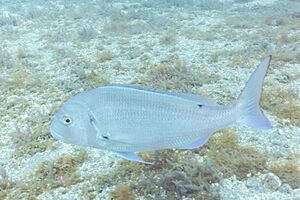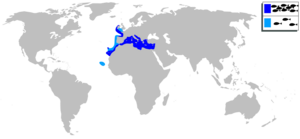Common dentex facts for kids
Quick facts for kids Common dentex |
|
|---|---|
 |
|
| Common dentex off Tenerife (Spain) | |
| Conservation status | |
| Scientific classification | |
 |
|
| Distribution map | |
| Synonyms | |
|
The common dentex (Dentex dentex) is a type of ray-finned fish that lives in the ocean. It belongs to the Sparidae family, which includes fish like seabreams and porgies. You can find this fish in the northeastern Atlantic Ocean and the Mediterranean Sea.
People really value the common dentex as a food fish. It's an important catch for fishing boats. However, its numbers have dropped a lot. Because of this, the International Union for Conservation of Nature says it is a "Vulnerable" species. This means it needs protection.
Contents
About the Common Dentex
What's in a Name?
The common dentex was first named Sparus dentex by a scientist named Carl Linnaeus in 1758. Later, in 1814, another scientist, Georges Cuvier, created the group (or genus) called Dentex. The common dentex then became the main example for this new group.
The name Dentex dentex is a bit special because both parts of the name are the same. "Dentex" means "with large teeth." This name perfectly describes the fish, as it has rows of sharp, canine-like teeth. The teeth at the front of its mouth are the biggest.
How to Spot a Common Dentex
The common dentex has an oval-shaped body that looks a bit flattened from side to side. Its dorsal fin (on its back) has 11 stiff spines and 11 or 12 soft rays. The anal fin (on its belly) has 3 spines and 7 to 9 soft rays.
Young dentex fish are greyish with black spots on their back and sides. As they get older, their color changes to pink. The oldest fish become bluish-grey, and their dark spots fade away.
This fish can grow quite large. The biggest common dentex ever recorded was about 100 centimeters (about 3.3 feet) long. However, most are around 50 centimeters (about 1.6 feet). The heaviest one found weighed about 14.3 kilograms (about 31.5 pounds).
Where They Live
The common dentex lives in the northeastern Atlantic Ocean. You can find it from the Bay of Biscay down to Mauritania, including the Canary Islands and Madeira. It's not very common in the northern parts, like near the British Isles. It also lives all over the Mediterranean Sea and even in the western Black Sea.
This fish prefers to live near the bottom of the sea, especially over rocky areas close to shore. It can be found at depths of up to 200 meters (about 650 feet). But it's most commonly seen between 15 and 50 meters (about 50 to 165 feet) deep.
Life in the Ocean
What They Eat
The common dentex is an active hunter. It eats other fish, mollusca (like clams and snails), and cephalopods (like squid and octopuses).
Social Life and Reproduction
For most of the year, the common dentex lives alone. But when it's time to reproduce, they gather in groups for a few weeks. This usually happens in the spring, when the water near the surface is warmer.
Studies have shown that both male and female dentex reach adulthood and can reproduce when they are 2 to 4 years old. Most common dentex are either male or female, but sometimes a fish can change sex. While adults are usually solitary, young dentex often swim together in schools.
Protecting the Dentex
The common dentex is a very valuable fish for food. It grows slowly, lives a long time, and gets quite big. These traits make it easy for the species to be overfished.
In areas like marine protected areas, where fishing is limited, the number of common dentex is higher. But outside these protected zones, they are much rarer. Fishing for common dentex increased a lot in the 1970s and 1980s. However, catches then fell sharply in the 1990s.
Scientists estimate that the total population of this species has dropped by more than 30% over the last 36 years. Because of this decline, the IUCN has listed the common dentex as a "Vulnerable" species.
Fishermen catch this fish using different methods, including bottom trawls, lines, fish traps, and sometimes trammel nets. It's also a popular fish for people who enjoy sport fishing. Some countries, like Spain, are even trying to raise this fish in aquaculture farms.


